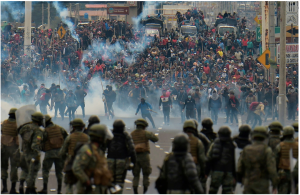The article I chose to evaluate was about Ecuadoran President Lenín Moreno’s decision to move his government seat from the capital of Ecuador, Quito, to a small coastal city 150 miles away. It was written by José María León Cabrera and published in the New York Times. President Moreno’s ability to move the government seat came from his declaration of a state of emergency, which allowed him to suspend certain civil liberties. He came to this decision as a result of the protests that took place on October 8, especially the storming of the National Assembly. The protests began as a result of Moreno’s implementation of a new austerity plan to lower debt and grow the economy.
The middle-class and indigenous response has been very vocal against Moreno’s measures toward his austerity plan. Moreno’s termination of a 40-year fuel subsidy caused a rise in fuel prices, much to the chagrin of transportation workers as well as young and Indigenous people who suffered immensely from Ecuador’s immense debt and radical tactics to emerge from the red. A coalition of indigenous groups stated that the protests “were a defense of ‘our life and our territories’”. Jaime Vargas, president of the Confederation of the Indigenous Nationalities of Ecuador, stated that “there will be no dialogue” between protesters and the Ecuadoran government if the austerity plan is not abolished.
This article, as well as the Western coverage of the topic in general, represents Latin America in a less than favorable light. Some of the language in the New York Times article, in particular, implies bias toward President Moreno, stating that moving his government seat was to “protect his government” and that he inherited a debt crisis from former President Correa’s many loans for special interest projects. In addition, the protestors are depicted as reacting negatively to Moreno’s policies despite their objective to improve the economy. These themes are recurring across many Western media platforms, even in video coverage. Many news clips and pictures from the protests display stereotypical behavior usually associated with anti-government protests, including rioting, looting, and destruction of property, with little to no focus on the issues at the heart of the protests or a reason behind them. These are common themes in the Western media coverage of the protests and arguably contribute to negative stereotypes of Latin America.

Protestors clash with Ecuadoran military. Credit: Rodrigo Buendia/Agence France-Presse — Getty Images

Protestors storm popular television station, Teleamazonas. Credit: BBC
Despite this, the New York Times article does give in-depth coverage of the topic, including an explanation of President Moreno’s actions as well as the timeline of significant events that led to them. Cabrera outlines the protestors’ reasoning behind their actions in accordance with Moreno’s new policies; however, the fact that the protestors’ reasoning is clear does not distract from the subtle bias in the reporting.
This current event is very reminiscent of all of the Latin American revolutions and reforms we have studied in our curriculum. In DeFronzo’s work, Social Movements and Revolutions, he outlines five critical factors of revolutionary movements:
- Mass frustrations
- Elite divisions
- Unifying motivations that cut across class lines
- Severe political crisis
- Tolerant/permissive world context
Cabrera outlines the mass frustrations with the timeline of events leading to Moreno’s decision to move his government seat, beginning with the protests as a result of the new measures in his austerity plan for economic growth. The elite divisions in the Ecuador conflict are evident because of the reaction of marginalized groups to Moreno’s new policies, as well as how these groups were actively affected by them. Subsequently, there are no unifying motivations across class lines because the upper-class and middle- and lower-classes are directly opposed. Those in lower classes and marginalized groups in Ecuadoran society are unified against the Ecuadoran government and military. The severe political crisis likely began when the rioting first began after Moreno’s announcement of the austerity plan, but the crisis came to a head with the storming of the National Assembly as well as Moreno’s moving of the government seat from the capital city of Quito. The permissive world context is seen in articles such as these that reach an international audience, which shows us why methodical reporting is vital and important. It is imperative that Western news sources take time to thoroughly examine both sides of political uprisings instead of mainly focusing on the actions of the government, as well as conforming to negative stereotypes about Latin America, even if on a subconscious level.
Sources:
Main Article: Cabrera, José María León. “Ecuador’s President Moves Seat of Government to Escape Protests.” New York Times. 8 Oct. 2019. The New York Times Company. Web. Accessed 14 Oct. 2019. https://www.nytimes.com/2019/10/08/world/americas/ecuador-protests-president.html
BBC Contributors. “Ecuador protests: Unrest continues over fuel price hikes.” BBC News. 12 Oct. 2019. BBC. Accessed 14 Oct. 2019. https://www.bbc.com/news/av/world-latin-america-50030470/ecuador-protests-unrest-continues-over-fuel-price-hikes?intlink_from_url=https%3A%2F%2Fwww.bbc.com%2Fnews%2Fworld%2Flatin_america&link_location=live-reporting-map
BBC Contributors. “Ecuador protesters storm parliament as unrest worsens.” BBC News. 9 Oct. 2019. BBC. Accessed 14 Oct. 2019. https://www.bbc.com/news/world-latin-america-49981521
BBC Contributors. “Ecuador violence: Protesters agree to talks with government.” BBC News. 13 Oct. 2019. BBC. Accessed 14 Oct. 2019. https://www.bbc.com/news/world-latin-america-50030720
Sims, Shannon. “Ecuador Declares State of Emergency as Striking Workers Block Roads.” New York Times. 9 Oct. 2019. The New York Times Company. Web. Accessed 14 Oct. 2019. https://www.nytimes.com/2019/10/03/world/americas/ecuador-transit-strike-fuel-subsidy.html?searchResultPosition=4


